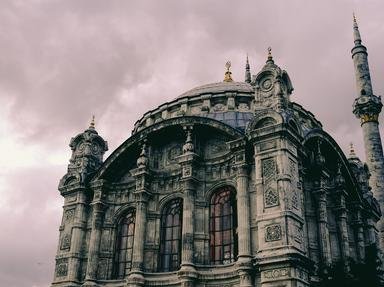Quiz Answer Key and Fun Facts
1. Suleiman's predecessors had greatly expanded the Ottoman Empire, and the new sultan was eager to continue their progress. The year after his coronation, he captured a prize that had eluded earlier sultans. What important city, then under Hungarian rule and now the capital of Serbia, fell to Suleiman in August 1521?
2. The next big Ottoman victory was in the Mediterranean. In 1522, after a six-month siege, Suleiman's armies conquered an island that had been a colossus of the Hellenic world. Its defenders were the heirs of the Crusaders, members of a military order called the Knights Hospitaller. Which island was this?
3. In one bloody battle after another, from Mohács to Buda, Ottoman armies brought the kingdom of Hungary to its knees. In 1529, Suleiman marched his men along the Danube through Austria, his mind set on the Habsburg capital -- but his attack failed. What was this city that became the high-water mark of Ottoman expansion in Europe?
4. Europe wasn't the only area that tempted the Ottomans under Suleiman: territorial disputes with the Persians led to more than twenty years of warfare. What major Mesopotamian city did the Ottomans capture in 1534?
5. Mediterranean shipping was vital to the Ottomans, and under Suleiman they maintained an immense navy. Their greatest admiral, Hayreddin Pasha, shared a nickname with a 12th-century Holy Roman Emperor. What was the nickname?
6. Westerners know Suleiman I as "Suleiman the Magnificent," but his own people came to call him by a different honorific: "Kanuni Suleiman." This refers to what major area of reform, undertaken during his reign?
7. Ottoman emperors tended not to marry; they regarded their dynasty as superior to all others, so no other royal families were worthy of a marriage alliance. Suleiman I, however, DID marry -- and the woman he married was a former slave of his harem. What was the Western name for this woman, who influenced her husband's politics?
8. Art and architecture flourished during Suleiman's reign. The great architect Mimar Sinan, who would later be honored on Turkish currency, got his start during that time. Which of the following buildings was NOT originally constructed by Sinan while Suleiman was sultan?
9. The Ottomans didn't only have a navy in the Mediterranean; they were in the Indian Ocean, too. They captured Aden in 1548 and Muscat in 1552, and even maintained a loose alliance with Aceh in what is now Indonesia. Against what European power were the Ottomans fighting in this ocean?
10. Suleiman I had many sons, but Ottoman palace politics made it impossible to sustain a happy family dynamic. The air was thick with intrigue. Brothers went to war against each other; Suleiman arranged the execution of two sons. In the end, who became sultan after Suleiman?
Source: Author
CellarDoor
This quiz was reviewed by FunTrivia editor
bloomsby before going online.
Any errors found in FunTrivia content are routinely corrected through our feedback system.

